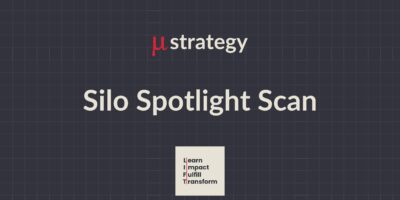Transform Data Into Results for Lasting Success
In the world of digital transformation, data is often heralded as the lifeblood of any modern enterprise. But simply having access to vast amounts of data doesn’t equate to success. It’s what we do with that data – how we collect, interpret, and act on it – that truly determines the outcomes of a transformation initiative. This is where the concept of Instruments comes into play in the PPPP-III Framework.
Instruments are the tools and systems we use to measure and track the performance of products, platforms, processes, and personas. Instruments provide leaders with the ability to make data-driven decisions, but more importantly, they serve as strategic guideposts – ensuring that every action taken is aligned with overarching business objectives.
While many organizations claim to be “data-driven,” far fewer manage to effectively harness that data to create measurable, successful outcomes. In this essay, I’ll explore how to implement a robust Instrument strategy within the PPPP-III Framework, showing you how to align your data with OKRs (Objectives and Key Results) and set up the systems necessary to deliver success.
What Are Instruments and Why Are They Critical?
An Instrument is any tool, metric, or system that helps you measure performance and guide decision-making. For a digital transformation, this might include tools like customer satisfaction surveys, net promoter scores (NPS), website analytics, and business intelligence platforms. The idea is to ensure that every decision is informed by data and that those data points are meaningful to the goals you’re trying to achieve.
But here’s the challenge: not all data leads to insight, and not all metrics are worth measuring. Too many organizations fall into the trap of tracking “vanity metrics” – numbers that look impressive but fail to drive meaningful change. For example, a high number of social media followers might look good on paper, but if those followers aren’t translating into engagement or conversions, they aren’t adding value.
From Data to Decisions
Instruments are only as good as their ability to provide actionable insights. This is where leaders play a crucial role.
As Carl Jung once said, “You are what you do, not what you say you’ll do.”
Leaders must not only promote data collection but also cultivate a mindset and culture where data is actively used to inform strategy and execution. Without this behavioral strength, data becomes just another checkbox rather than a driver of transformation.
Illustration: In the Fintech industry, companies like PayPal rely heavily on data to optimize the customer experience. They measure everything from transaction speed to customer satisfaction. But more importantly, they take action based on these insights. If their data shows an uptick in customer complaints about security features, they immediately dedicate resources to enhance those features, preventing customer churn and building trust.
For PayPal , Instruments are not just numbers—they are direct inputs that shape product evolution, improve processes, and ensure that the business remains competitive in a rapidly evolving market.
Instruments and OKRs: Align Data with Goals
To ensure that Instruments drive meaningful outcomes, they must be tightly aligned with Objectives and Key Results (OKRs). OKRs are an effective tool for setting and measuring progress toward ambitious goals. By combining OKRs with well-chosen Instruments, organizations can create a clear roadmap for success.
Let’s break it down using an illustration.
Objective: Launch a mobile banking app that increases customer engagement by 25% within 12 months.
Key Results:
1. Increase mobile app downloads by 40%.
2. Achieve a customer satisfaction score of 85% or higher.
3. Reduce customer service inquiries by 20%.
To achieve these key results, the right Instruments must be in place. For example:
- Mobile app analytics will track the download rate.
- Customer satisfaction surveys will measure the experience.
- Customer service dashboards will show whether inquiries are declining as a result of improved app features.
When Instruments and OKRs are closely aligned, teams have a clear view of what success looks like and can make data-driven adjustments in real-time to stay on course.
Avoid Vanity Metrics: Measure What Really Matters
One of the most common mistakes in any transformation effort is focusing on vanity metrics – numbers that give the illusion of success but fail to create real value. Instead, the focus should be on actionable metrics that align with strategic goals.
Take website traffic, for example. High traffic might seem like a success, but if the majority of visitors leave after only a few seconds, this traffic is meaningless. A more valuable metric might be conversion rate – the percentage of visitors who take a desired action, such as signing up for a newsletter or making a purchase.
Simon Sinek, in his book Start With Why, reminds us to focus on why we’re measuring things in the first place. If the metric doesn’t help us achieve our why – our larger purpose – then it’s not worth tracking.
Illustration: Consider a Fintech startup looking to increase its user base. Instead of measuring success by the total number of downloads, they should focus on metrics like active users and retention rate. These numbers offer a clearer picture of whether users find the products and services valuable and the platform easy to use and navigate – and are likely to stay.
Real-Time Data enables Real-Time Decisions
In a fast-paced world, the ability to make real-time decisions is critical. This is where Instruments become particularly valuable. By setting up dashboards and real-time analytics tools, leaders can quickly identify trends, spot bottlenecks, and adjust before small problems become big ones.
Adam Grant, in Think Again, highlights the importance of rethinking assumptions based on new information. He argues that leaders must be flexible, willing to adjust their strategies based on what the data is telling them in real time.
Illustration: Take Amazon Web Services (AWS), where real-time data is used to ensure seamless cloud performance. AWS tracks uptime, latency, and customer support tickets in real time. If the data shows a sudden spike in service requests, AWS can immediately allocate resources to resolve issues, preventing service disruptions.
Jeff Bezos encapsulates Amazon’s commitment to data informed real time decisions, “We are stubborn on vision. We are flexible on details.”
For leaders in the midst of digital transformation, real-time data is an essential tool for course-correcting before things go off track.
Instruments are Tools for Innovation
Instruments not only guide current performance but can also fuel innovation. By closely monitoring the right data points, organizations can identify new opportunities, customer needs, and areas ready for innovation.
Illustration: Take the example of Netflix. Their Instrument strategy doesn’t just track how many people are watching a particular show. Instead, they gather data on when viewers pause a show, which parts they re-watch, and how often they binge-watch a series. These insights allow Netflix to tailor its recommendations, optimize content development, and even predict which new shows will resonate with audiences.
By turning data into insights, Netflix stays ahead of the competition, constantly innovating to meet the evolving needs of its customers.
Measure the Intangibles: Culture and Customer Trust
While many Instruments are focused on tangible metrics like downloads or conversion rates, leaders must also measure the intangibles – the elements that are harder to quantify but equally important for long-term success.
Two critical areas that need to be measured are:
1. Organizational Culture: Is your company culture aligned with the mission – transformation goals? Do employees feel empowered to use data in decision-making, or is there resistance? Anonymous employee surveys and engagement scores can provide insight into whether culture is moving in the right direction.
2. Customer Trust: Are your customers confident in your products and services? Trust is an intangible yet critical metric, especially in industries like fintech, where security and reliability are paramount. Net promoter scores (NPS), customer feedback, and churn rates are effective ways to gauge customer trust.
As Carl Jung noted, “We cannot change anything until we accept it.”
By accepting the challenge of measuring and improving these intangibles, leaders can build a more resilient organization that thrives on both metrics and culture.
Instruments facilitate Cross-Functional Alignment
A common pitfall in many organizations is siloed decision-making. Instruments can play a key role in breaking down these silos by ensuring that cross-functional teams are aligned with the same data and objectives.
In transformation efforts, it’s essential that everyone – whether in marketing, engineering, or customer service – uses the same Instruments to measure a common definition of progress. This not only ensures consistency but also promotes a shared understanding of success.
Illustration: At Apple, cross-functional alignment is a core principle. Whether it’s product development, marketing, or operations, all teams are aligned with the same Instruments to track customer satisfaction, product performance, and innovation pipelines. This ensures that every decision is rooted in the same set of data, leading to cohesive and agile execution across the organization.
Apple’s commitment to alignment is rooted in what Steve Jobs once said, “Great things in business are never done by one person; they’re done by a team of people.”
Instruments are the Backbone of Transformation and Business Growth
In the PPPP-III Framework, Instruments serve as the backbone of any successful transformation or business mission. They enable leaders to measure what matters, align data with OKRs, and make informed decisions that drive both immediate and long-term success.
But Instruments are more than just tools – they are a mindset. By cultivating a culture where data is both respected and used, leaders can create organizations that thrive in uncertainty, adapt to change, and consistently deliver value to customers.
As we continue our journey through the PPPP-III Framework, the question to ask yourself is this: Are your Instruments aligned with your goals? Are you measuring what matters, or are you getting lost in vanity metrics? Are your teams equipped to act on the data, or is decision-making still based on assumptions and gut feelings?
The challenge of modern leadership isn’t just gathering data—it’s turning that data into actionable insights that guide your organization toward its most ambitious objectives. With the right Instruments in place, aligned with a clear set of OKRs, you have the tools needed to track, adjust, and ultimately deliver successful outcomes.
As we wrap up the sixth part of the PPPP-III Framework, remember this:
Instruments are not just about the numbers – they’re about understanding the story behind the data and using that story to inform every decision you make.
By aligning your Instruments with the broader strategy and goals, you will transform data into a competitive advantage that fuels growth, innovation, and resilience.
The journey continues with the next installment of the PPPP-III Framework series, where we’ll dive into Insights—the art of turning data into knowledge, and how to use that knowledge to drive transformation forward.
What Instruments are you using in your organization? How are you turning data into actionable insights that drive real outcomes?
We are all doing our best ~ please Assume Positive Intent!
Let me know how I can help.
Adi








Comments